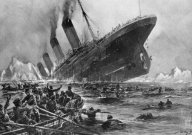
Image credit: Willy Stower
Mystery and controversy aboard RMS Titanic
It was a Sunday, the date: April 14, 1912. Those aboard the RMS Titanic were worry free, some coming to the United States as emigrants, others traveling for pure pleasure. However, the North Atlantic in springtime is freezing and filled with icebergs, lots and lots of icebergs. No reason to fear, the owners of this immense ship said, because it was "virtually unsinkable!" Nothing could possibly sink this ship, right? Wrong! At 11:40 p.m., a lookout spotted an iceberg straight ahead. However, the ship was going "Full speed ahead!" as Captain Edward J. Smith instructed earlier and it was hard to avoid it. The iceberg ripped an over two hundred foot long hole in the hull and the ocean liner sunk two hours and forty minutes later, at 2:20 a.m. the following day.
We've all heard the story of the Titanic... but is that the story that really played out? Could there be a hidden truth to the sinking of this ship?
Believe it or not, the company that built the Titanic never said that it was unsinkable, rather they believed that this myth was interpreted differently by people reading articles in the Irish news and Shipbuilder magazine. Even the Vice President of the company that owned the Titanic believed it to be unsinkable. Obviously it wasn't, though, as many found out. And interestingly enough, the same story took place in three different literary works, before the mighty ship sunk.
Morgan Robertson was a well-known author, most famous for his novella Futility, or the Wreck of the Titan. The plot of the book revolves around former U.S. Navy officer John Rowland. Dismissed from the Navy, he now works as a deckhand on the huge ocean liner Titan.
There are many similarities between the Titan and the Titanic. For example, in the book, the Titan was eight hundred feet long whereas the Titanic was 882 feet and nine inches long. The Titan also sank in the North Atlantic in April near midnight and there weren't enough lifeboats for those aboard. Also, Futility says that the Titan traveled at 25 knots (28.75 mph) while, in reality, the Titanic traveled at 22.5 knots (25.9 mph).
However, there are altogether creepier literary coincidences of Titanic fortune-telling, written by Victorian journalist William Thomas Stead.
Stead wrote both an article and a novel that seem to be based upon the sinking of the Titanic, even though they were both written over twenty years before its maiden voyage. The article was published in the Pall Mall Gazette on March 22, 1886 and was titled "How the Mail Steamer Went Down in Mid-Atlantic, by a Survivor". In this piece, Stead tells of a steamship that sinks after colliding with another ship. Not exactly the story of the Titanic; although, it does say that many died due to a lack of lifeboats. He wrote, "This is exactly what might take place and will take place if liners are sent to sea short of boats".
Stranger still, his 1892 book From the Old World to the New tells of a vessel, the Majestic, that rescues people victims of an iceberg that collided with their ship. The captain of the Majestic was Edward J. Smith, the same name of the captain of the Titanic!
William Thomas Stead boarded the Titanic to go to the United States and take part in a peace congress at Carnegie Hall at request of President William Howard Taft. He never made it to the U.S. Oddly enough, Stead had always claimed he would either die from lynching or drowning.
With such creepy coincidences, some wonder if these really were coincidences. One conspiracy theory has emerged concerning the sinking of the RMS Titanic and if it was deliberate. It is the Federal Reserve Titanic conspiracy which states that some of the wealthiest and most powerful men of that day were coaxed aboard the Titanic because those whom thought up the Federal Reserve didn't want these specific men to oppose the idea.
Coincidences and conspiracies are not of the stranger front. A little girl named Jessie in Scotland lay on her bed dying and hours before the Titanic sank, she envisioned drowning passengers and "someone called Wally…playing a fiddle." Wallace, or Wally, Hartley was a musician of the Titanic and died playing his fiddle. Similarly, New York attorney Isaac Frauenthal had a dream about the sinking liner the night before he boarded. He said, "It seemed to me that I was on a big steamship that suddenly crashed into something and began to go down." He had the same dream again aboard the Titanic. When he woke up to the warning of the collision with the iceberg, he fled to a lifeboat and survived.
There certainly are strange stories, conspiracies, coincidences and precognition concerning the Titanic. So ask yourself, are you still going on that luxury cruise?




You can feel the Titanic experience as soon as you enter the building.Titanic Ireland
ReplyDelete